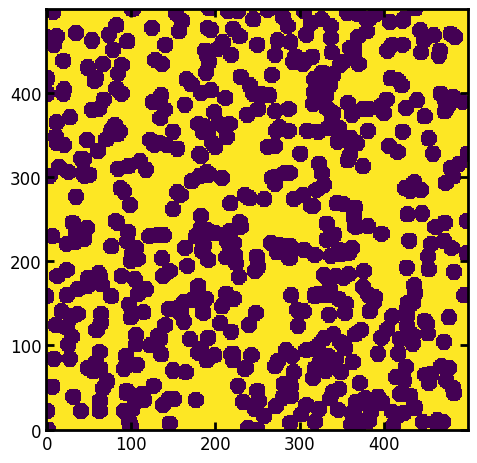SNOW partitioning#
The filter is used to partition an image into regions using the SNOW algorithm which stands for the subnetwork of the oversegmented watershed. The steps taken are described in detail in the snow_advanced notebook. We provide a filter function that combines all the steps and it is explored here:
import matplotlib.pyplot as plt
import numpy as np
from skimage.morphology import binary_dilation
import porespy as ps
ps.visualization.set_mpl_style()
np.random.seed(1)
im = ps.generators.overlapping_spheres([500, 500], r=10, porosity=0.5)
fig, ax = plt.subplots()
ax.imshow(im, origin="lower");

snow_out = ps.filters.snow_partitioning(im, r_max=4, sigma=0.4)
print(snow_out)
――――――――――――――――――――――――――――――――――――――――――――――――――――――――――――――――――――――――――――――
Results of snow_partitioning generated at Fri Dec 5 19:34:36 2025
――――――――――――――――――――――――――――――――――――――――――――――――――――――――――――――――――――――――――――――
im Array of size (500, 500)
dt Array of size (500, 500)
peaks Array of size (500, 500)
regions Array of size (500, 500)
――――――――――――――――――――――――――――――――――――――――――――――――――――――――――――――――――――――――――――――
fig, ax = plt.subplots(2, 2, figsize=[8, 8])
ax[0, 0].imshow(snow_out.im, origin="lower")
ax[0, 1].imshow(snow_out.dt, origin="lower")
dt_peak = snow_out.dt.copy()
peaks_dilated = binary_dilation(snow_out.peaks > 0)
dt_peak[peaks_dilated > 0] = np.nan
ax[1, 0].imshow(dt_peak, origin="lower")
ax[1, 1].imshow(ps.tools.randomize_colors(snow_out.regions), origin="lower")
ax[0, 0].set_title("Binary image")
ax[0, 1].set_title("Distance transform")
ax[1, 0].set_title("Distance transform peaks")
ax[1, 1].set_title("Segmentation");

